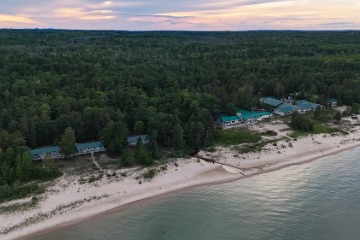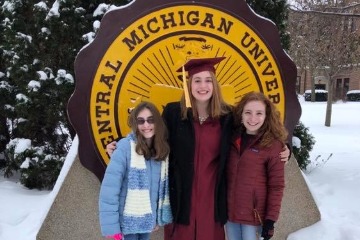Beaver Island Institute makes waves
Weeklong experience through CMU equips teachers for the school year and beyond
As winter approaches, several Michigan schoolteachers are fondly remembering their summer days at an island getaway — but it was no mere vacation.
The location was the Central Michigan University Biological Station on Beaver Island, the summer days were the weeklong 2019 Beaver Island Institute, and the fond memories are driving innovative learning across the state throughout the school year and beyond.
CMU faculty members Troy Hicks in teacher education and professional development and Wiline Pangle in biology present the annual institute for Michigan teachers, with support from other K-12 teacher leaders.
“Originally we designed the institute for middle school science and language arts teachers,” Hicks said, “but it’s expanded now to welcome elementary and high school teachers across many K-12 subjects.”
The program focuses on experiences for teachers that, in turn, will spark children’s natural curiosity, build their scientific literacy skills, and expose them to technology and data in the classroom. It aligns with Michigan’s implementation of Next Generation Science Standards and Common Core State Standards for English Language Arts.
“The Institute is built on collaboration,” Pangle said, “with pairs of teachers from the same school attending together, typically an English language arts teacher paired with a science teacher — but sometimes art teachers, as well — to break down walls between disciplines.”
Hicks said the professional experience for teachers helps put kids at the center of science learning: “We need students to experience a phenomenon first — and that will get them interested and asking questions.”
Educators give high marks
Troy Hicks said participating teachers evaluating their experience with the Beaver Island Institute over the past four years consistently rate it as one of their best professional learning opportunities. Contact him to learn about the 2020 institute: troy.hicks@cmich.edu.
Not the captain anymore
“My students now do science, not just read about science,” said CMU alum Todd Starry, who teaches middle school science in St. Louis, Michigan.
Starry, one of 14 teachers at this year’s institute in August, also attended the first institute in summer 2016. It’s changed his way of thinking about the classroom, and he now trains other staff in methods he has learned from the institute.
“My teacher evaluations have improved, and my classroom is student-driven in many ways,” he said. “My main purpose is to steer the ship, not be the captain anymore.”
The real measure of success?
“My students this year will be more prepared for high school than any group I have taught in 13 years.”
Here’s how Starry and three other Michigan teachers are turning their Beaver Island Institute experience into practical classroom innovations:
Karyn McConachie, Eppler Junior High, Utica
- Teaches: Eighth grade environmental science and ninth grade physical science.
- Attended the Beaver Island Institute: 2019.
- Classroom activity: “My ninth grade students will complete and present their own group-led static electricity demonstration and then individually will create an infographic to explain their learning.”
- Institute takeaway: “The infographic was a literacy strategy I learned during the institute that I think will really allow students to create an authentic way of demonstrating their learning.”

Todd Starry, T.S. Nurnberger Middle School, St. Louis
- Teaches: Sixth and seventh grade science.
- Attended the institute: 2016 and 2019.
- Classroom activity: “Our Pine River study is a foundation for the classroom and its focus on energy and matter. I have changed this experience a great deal after the institute. I collected samples from the river before, but the way we look at the specimens and how we record them have changed because of the institute. Students will collect and classify macroinvertebrates from the river, then make an art project based on the insects they saw the day before.”
- Institute takeaways: “I have learned to make my lessons inquiry-based and led by students. I think it has helped all the students who may not have learned well from a book. Students who want to look up the correct answer and write it down no longer enjoy my class, because they cannot do that. As one student said last year, ‘You make us think so much my head hurts.’”

Jennifer Tapolcai, Bothwell Middle School, Marquette
- Teaches: Seventh grade science and environmental science.
- Attended the institute: 2017 and 2019.
- Classroom activity: “In a writing exercise to learn about graphs, students work with a partner to address seven prompts to write and learn about the pressure and temperature changes throughout the layers of an atmosphere graph. Historically, this has been a challenging graph for students to understand, but this structured process of understanding it allowed all students to experience success.”
- Institute takeaway: “The ‘phenomena-first’ philosophy has transformed my classroom into an inquiry-based science room. Students are so much more engaged and make greater connections. I've learned so much that I've actually been able to use in my classroom.”

Lindsay Thurman, Highlander Way Middle School, Howell
- Teaches: English language arts.
- Attended the institute: 2017.
- Classroom activity: “ In ELA, our students each researched an organism in a certain ecosystem. Once students had their information, they created a presentation of their choice: poster, slide show, create a model, create a book — I even had a student dress up as their animal. We talked about good presentation skills, then the fifth graders came over and listened to the students present information about their organism.”
- Institute takeaway: “Cross-curriculum activities have helped our students. I notice more engagement when students are working through content in my classroom through a different medium. You can see them work through their understanding of content to help make meaning. What was great was the crossover in vocabulary and content from science into ELA. Students had an extra opportunity to think about the content in a different way.”




